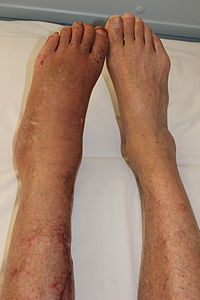
Photo from wikipedia
Background andObjectives: This 10-year multicenter retrospective study reviewed the clinical manifestations, diagnostic tests, and treatment modalities of tubercular uveitis (TBU), including direct infection and indirect immune-mediated hypersensitivity to mycobacterial antigens… Click to show full abstract
Background andObjectives: This 10-year multicenter retrospective study reviewed the clinical manifestations, diagnostic tests, and treatment modalities of tubercular uveitis (TBU), including direct infection and indirect immune-mediated hypersensitivity to mycobacterial antigens in Taiwan. Materials and Methods: This retrospective chart review of patients with TBU was conducted at 11 centers from 1 January 2008 to 31 December 2017. We used a multiple regression model to analyze which factors influenced best-corrected visual acuity (BCVA) improvement. Results: A total of 79 eyes from 51 patients were included in the study. The mean age was 48.9 ± 16.4 years. The mean change of LogMAR BCVA at last visit was −0.21 ± 0.45. Diagnostic tools used include chest X-ray, chest computed tomography, Mantoux test, interferon gamma release test (QuantiFERON-TB Gold test), intraocular fluid tuberculosis polymerase chain reaction, and bronchial alveolar lavage. The clinical manifestations included 48% posterior uveitis and 37% panuveitis. In the sample, 55% of the cases were bilateral and 45% unilateral. There was 60.76% retinal vasculitis, 35.44% choroiditis, 21.52% serpiginous-like choroiditis, 17.72% vitreous hemorrhage, 12.66% posterior synechiae, 6.33% retinal detachment, and 3.80% choroidal granuloma. Treatment modalities included rifampicin, isoniazid, pyrazinamide, ethambutol, oral steroid, posterior triamcinolone, non-steroidal anti-inflammatory drugs, vitrectomy, and immunosuppressants. BCVA improved in 53.2% of eyes and remained stable in 32.9% of eyes. In the final model of multiple regression, worse initial BCVA, pyrazinamide, and receiving vitrectomy predicted better BCVA improvement. Ethambutol was associated with worse visual outcomes. Seven eyes experienced recurrence. Conclusions: This is the largest 10-year multicenter retrospective study of TBU in Taiwan to date, demonstrating the distribution of clinical manifestations and clinical associations with better treatment outcomes. The study provides a comprehensive description of TBU phenotypes in Taiwan and highlights considerations for the design of further prospective studies to reliably assess the role of ATT and vitrectomy in patients with TBU.
Journal Title: Medicina
Year Published: 2022
Link to full text (if available)
Share on Social Media: Sign Up to like & get
recommendations!